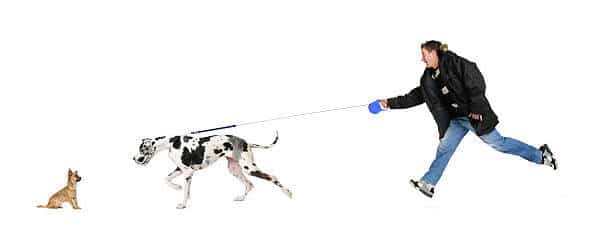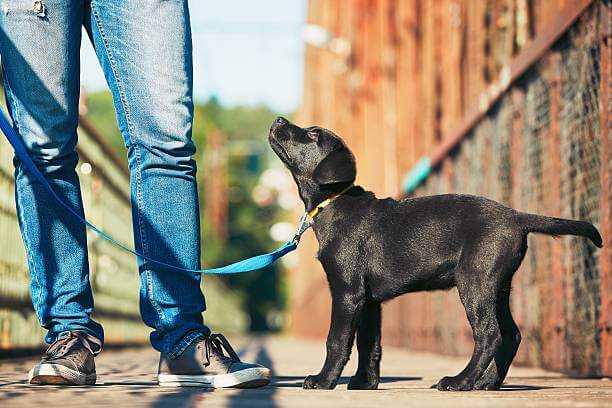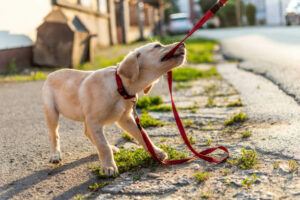Dogs must be trained. That is important for your safety and that of your dog. You can’t forget the squirrels your dog might chase if you don’t. Leash training is crucial for dogs and puppies. All dogs have a prey drive that can cause them to run off and get lost.
Dog parents and their dogs need to learn how to leash train their dog correctly. These tips will help you get your puppy walking on a leash in no time. That will allow for peaceful walks.
Your dog cannot run off-leash, no matter what you and your pups want. Teach your dog or puppy how to walk on a leash.
At What Age Should You Begin Leash Training your Puppy?
Train a dog to wear a collar or harness. Then, you can add the leash. Your dog or puppy should be able to wear the accessory without discomfort.
It’s best to start training your dog while he is still a puppy. You can begin preparing your puppy to walk on a leash at around four to six weeks of age. Puppies are like children.
You will need the following to begin leash training your dog:
- Patience and a positive outlook are two key ingredients.
- Treats – Go with your dog’s favorite treat
- When getting started, a leash of at least 4-6 feet (about 1-2m) is recommended.
- Optional GPS dog tracker – Untrained dogs and puppies can run at any time – a tracker will make it easy to locate your friend in seconds
- Collar or harness: A buckle, Martingale collar, or head halter will work.
Tie the leash to the harness or collar while your dog is inside. Let him become familiar with it.
Dog Leash Training Techniques
Once you have everything you need, you can start leash training your dog or puppy. Here are two standard methods for dog leash training: Heel training or loose leash walking.
1. Teach your dog how to heel

You can teach your dog the “heel” cue if he stays with you consistently. It’s simple to say once, and your dog will be rewarded for coming to you.
Give your dog a cue to let you know when it’s time to stop, and then throw a treat in their direction. You can repeat the process outdoors until your dog is proficient at heeling.
Heeling is a dog leash option. This technique allows your dog to walk on your right or left side, depending on what is most comfortable for him. Your dog should follow your lead and stop whenever you stop. When your dog requires attention, heeling can be used. It can be too restrictive for your dog’s daily walks.
You can take a step ahead and lure your dog with a treat. Once he is at your side, reward him.
Keep doing this while you move about. Reward your dog only when he is with you. Do not reward your dog when he becomes distracted. Instead, guide him back to you and begin again.
You can mix it up. You can increase the pace or slow down – but only reward your dog when he’s with you.
2. Train your dog how to walk loosely.
You can use a loose leash to train your dog. You can lure your dog to your left with a delicious treat. Reward him for being next to you. Please keep your dog happy by rewarding him often.
This option allows you to train your dog how to walk on the leash without tension. You should train your dog to walk within the limits of the leash. You can instruct your dog to walk with a loose leash by following the steps below.
- Reward your dog by calling him to your side and giving him a treat.
- Practice your skills in the house, but don’t use the leash at first.
Move forward, engaging your dog as you go. Give your dog another treat when he comes back to you. Continue this routine walking around the house until your dog is comfortable and eagerly awaits his next treat.
These steps can be repeated, but with the collar or harness on and the leash attached.
After your dog is comfortable walking on a loose leash inside, you can take him outside. You can practice in a quiet area until your dog is comfortable with it.
Why is it Important to Train Your Dog on a Leash?
Your dog must communicate with you by observing the tension of the leash (loose or tight). Your dog may be frightened or ready to fight if the leash becomes taut suddenly. The way you hold the leash can communicate to your dog what you feel.

It is crucial to teach your dog how to walk on a leash. Let’s take a look at why it is so important. There are several reasons training your dog or puppy on a leash is so important for dog parents:
You’ll likely get frustrated if your dog pulls at the leash. You might lose your temper or feel resentful for having to walk your dog. You might even use punishment. These things can hurt your relationship with your furry friend.
Dog owners should not pull on their dog’s leashes too often. That can lead to serious health problems. It could result in injury to their necks and stress on their joints.
If your dog feels like he “has” to pull against the leash, he will also get frustrated. That could cause your dog to be aggressive or stress-out. It could lead to your dog threatening other dogs.
Dog leash training is essential because we love our dogs and don’t want them in danger. It is feasible to train a dog on a leash, making it easier than you might think.
How to Fix Common Problems in Dog Leash Training
You can play games with your dog, teach him new commands, and give him treats.
During leash training, your dog may be reluctant to cooperate at times. Don’t allow pulling, lunging, or barking to get in the way of your leash training. You can use these tips while your dog is learning the best leash walking manners.
As a dog parent, you must be ready to comply with all laws in your area that pertain to dogs. When you travel with your dog, make sure that you comply with all applicable dog laws.
Stop walking immediately. You shouldn’t pull him with the leash. You can call him over, praise him when you see him, and then walk on. As it could hurt your dog, don’t continue walking if your puppy pulls on the leash. Drawing on the leash is an indication that your dog needs more exercise.
Be safe and keep your dog on the leash: Violations of laws governing dog leashes can cause severe consequences.
It’s essential to follow all dog leash laws and use a leash:
- In crowded areas or high-traffic areas
- If your dog is not yet trained
- If your dog is aggressive or displays other behavioral problems
- During spring and wildlife breeding season
A GPS dog tracking device can become your best friend, as well as a leash. It allows you to track your dogs anywhere, anytime, and in real-time, regardless of how far they may wander.
Last Tips for Leash Training a Dog or Puppy
Before you go outdoors, start training indoors. Allow your dog to come to you and reward good behavior with treats.
Every dog-human relationship should include leash training. As early as four weeks old, you can begin leash training your dog. Begin by getting your dog to use the leash, collar, or harness.
Leash-training a dog or puppy takes patience, time, and lots of positive reinforcement. Whatever you do, remember to be calm and patient with your dog. You will soon be able to walk on the leash together with the help of the tips and consistent effort.
Conclusion – The Guide to Leash Training a Dog or Puppy
For total security and peace of mind, use a GPS dog tracker. During the leash training process, be patient, positive, and kind to your dog.
Did you find this article useful? Feel free to share your thoughts. We would be happy to hear from you!
Stay tuned for more posts on dog care and much more!
“May Your Home Be Filled With Love And Dog Hair”
Any/all links on this site may be affiliate links, and if you make a purchase through one of them, I will earn a small commission at no extra cost to you. Read the full affiliate disclosure here.
“As an Amazon Associate, I earn from qualifying purchases.”
Mark
Founder of Our Dogs World 101


This is important. You get dogs that are very naughty and need to be trained at a very young age. I once had a dog but he was very naughty because I did not train him when he was young. I eventually had to let him go. I will be sure to share this article with friends and family who have dogs
Thanks Daniel
I wish I had come across this article a while back when trying to leash train my dog! Most of the time when I take him out, he behaves well. If something gets his attention though, he is walking me at that point! He is a very strong dog, very muscular! He worries me with his pulls sometimes, I am afraid it is going to hurt him.
You may want to look at getting either a harness or an Ecollar.